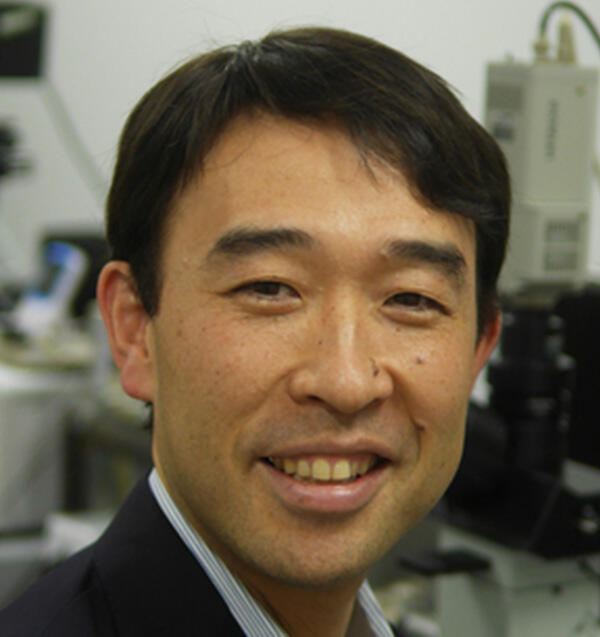Tetsuya Higashiyama
Affiliated Researcher/Visiting Professor, University of Tokyo, Professor
Website:http://www.liveholonics.com/en/
Plant reproduction, peptides, micro-genomics, cell manipulation, live cell imaging
Higashiyama is one of the most recognized plant biologists focusing on the identification of key molecules of plant reproduction. In particular, his discovery of the long-sought (~140 years) pollen tube attractant molecule "LURE", which is essential for plant reproduction, has secured his position as a world-renowned biologist. The identification of LURE peptides provide us with a major breakthrough to study and control pollen tube guidance of flowering plants and to break reproductive barriers. Moreover, he has also made significant technical development of micro-genomics and live cell imaging. Currently, he serves as one of the youngest directors of prestigious ERATO funding program supported by the Japan Science and Technology Agency. He will be involved mainly in the development of molecules that can overcome species barriers as well as innovative bio-imaging tools, collaborating with the groups of Yamaguchi, Irle, Torii, Itami, Ooi, Crudden, and Bode.
Profile
| 1994 | B.S.; The University of Tokyo (Plant Biology) |
| 1996 | M.S.;The University of Tokyo (Biological Science) |
| 1999 | Dr. Sci.; The University of Tokyo (Biological Science) |
| 1998-1999 | JSPS Research Fellow;The University of Tokyo, JAPAN |
| 1999-2006 | Assistant Professor; Graduate School of Science, The University of Tokyo |
| 2007-present | Professor; Graduate School of Science, Nagoya University |
| 2008-2011 | JST PRESTO Researcher |
| 2010-2017 | Director; ERATO Higashiyama Live-Holonics Project, JST |
| 2013-present | Vice-Director, Professor; WPI-ITbM, Nagoya University |
Research Highlights
- Breakthrough for designed hybridization of plants
- Plants that Save the World: Fertilization Control and Production of New Plant Species
- Gene inhibition method for pollen tubes using oligonucleotides
- Cell fusion 'eats up' the 'attractive cell' in flowering plants
- A fluorescent dye that survives in live cell STED imaging ~A new molecular tool for continuous super-resolution fluorescence microscopy~
- Where males sense females in plants ~Unraveling the unknown receptors and mechanism for fertilization in plants~
- AMOR, a love potion for plant fertilization
- Plant's POEM: "No need to fertilize, for increase in seed size"
- Three rings stop cell division in plants
- Live cell imaging of asymmetric cell division in fertilized plant cells
- Unlocking the mystery of pollen tube guidance
Selected Awards and Honors
| 2018 | 2018 (71st) Chunichi Cultural Award, Chunichi Shimbun |
| 2017 | 34th Inoue Prize of Science, Inoue Foundation for Science |
| 2017 | 25th Kihara Memorial Foundation Academic Award, Kihara Memorial Yokohama Foundation for the Advancement of Life Sciences |
| 2014 | President of the International Association of Sexual Plant Reproduction Research |
| 2014 | NISTEP Award, National Institute of Science and Technology Policy |
| 2014 | 20th Yomiuri Techno Forum Gold Medal Prize |
| 2013 | Hirase Award, Japan Society of Plant Morphology |
| 2010 | JSPS Prize, Japan Society for the Promotion of Sciences |
Selected Publications
- Maruyama, D.; Völz, R.; Takeuchi, H.; Mori, T.; Igawa, T.; Kurihara, D.; Kawashima, T.; Ueda, M.; Ito, M.; Umeda, M.; Nishikawa, S.; Groß-Hardt, R.; Higashiyama, T. Cell 2015, 161, 708. Rapid Elimination of the Persistent Synergid through a Cell Fusion Mechanism. DOI: 10.1016/j.cell.2015.03.018
- Hamamura, Y.; Nishimaki, M.; Takeuchi, H.; Geitmann, A.; Kurihara D.; Higashiyama, T. Nature Commun. 2014, 5, 4722. Live imaging of calcium spikes during double fertilization in Arabidopsis. DOI: 10.1038/ncomms5722
- Maruyama, D.; Hamamura, Y.; Takeuchi, H.; Susaki, D.; Nishimaki, M.; Kurihara, D.; Kasahara, R. D.; Higashiyama T. Dev. Cell 2013, 25, 317. Independent control by each female gamete prevents the attraction of multiple pollen tubes. DOI: 10.1016/j.devcel.2013.03.013
- Takeuchi, H.; Higashiyama, T. PLoS Biol. 2012, 10, e1001449. Species-specific cluster of defensin-like genes encodes diffusible pollen tube attractants in Arabidopsis. DOI: 10.1371/journal.pbio.1001449
- Hamamura, Y.; Saito, C.; Awai, C.; Kurihara, D.; Miyawaki, A.; Nakagawa, T.; Kanaoka, M. M.; Sasaki, N.; Nakano, A.; Berger, F.; Higashiyama, T. Curr. Biol. 2011, 21, 497. Live-cell imaging reveals the dynamics of two sperm cells during double fertilization in Arabidopsis thaliana. DOI: 10.1016/j.cub.2011.02.013
- Okuda, S.; Tsutsui, H.; Shiina, K.; Sprunck, S.; Takeuchi, H.; Yui, R.; Kasahara, R. D.; Hamamura, Y.; Mizukami, A.; Susaki, D.; Kawano, N.; Sakakibara, T.; Namiki, S.; Itoh, K.; Otsuka, K.; Matsuzaki, M.; Nozaki, H.; Kuroiwa, T.; Nakano, A.; Kanaoka, M. M.; Dresselhaus, T.; Sasaki, N.; Higashiyama, T. Nature 2009, 458, 357. Defensin-like polypeptide LUREs are pollen tube attractants secreted from synergid cells. DOI: 10.1038/nature07882
- Higashiyama, T.; Yabe, S.; Sasaki, N.; Nishimura, Y.; Miyagishima, S.; Kuroiwa, H.; Kuroiwa, T. Science 2001, 293, 1480. Pollen tube attraction by the synergid cell. DOI: 10.1126/science.1062429
- Members
- Yoshimura Group
- Yamaguchi Group
- Bode Group
- Crudden Group
- Frommer Group
- Itami Group
- Kamikouchi Group
- Hirota Group (collaborating with Kay)
- Kinoshita Group
- Ooi Group
- Tama Group
- Shimotohno Group (collaborating with Torii)
- Tsuchiya Group
- Yanai Group
- Laohavisit Group
- Mizuta Group
- Phung Group
- Kurihara Group
- Molecular Structure Center
- Live Imaging Center
- Chemical Library Center
- Peptide Protein Center
- Administrative Department
- Affiliated Researchers

